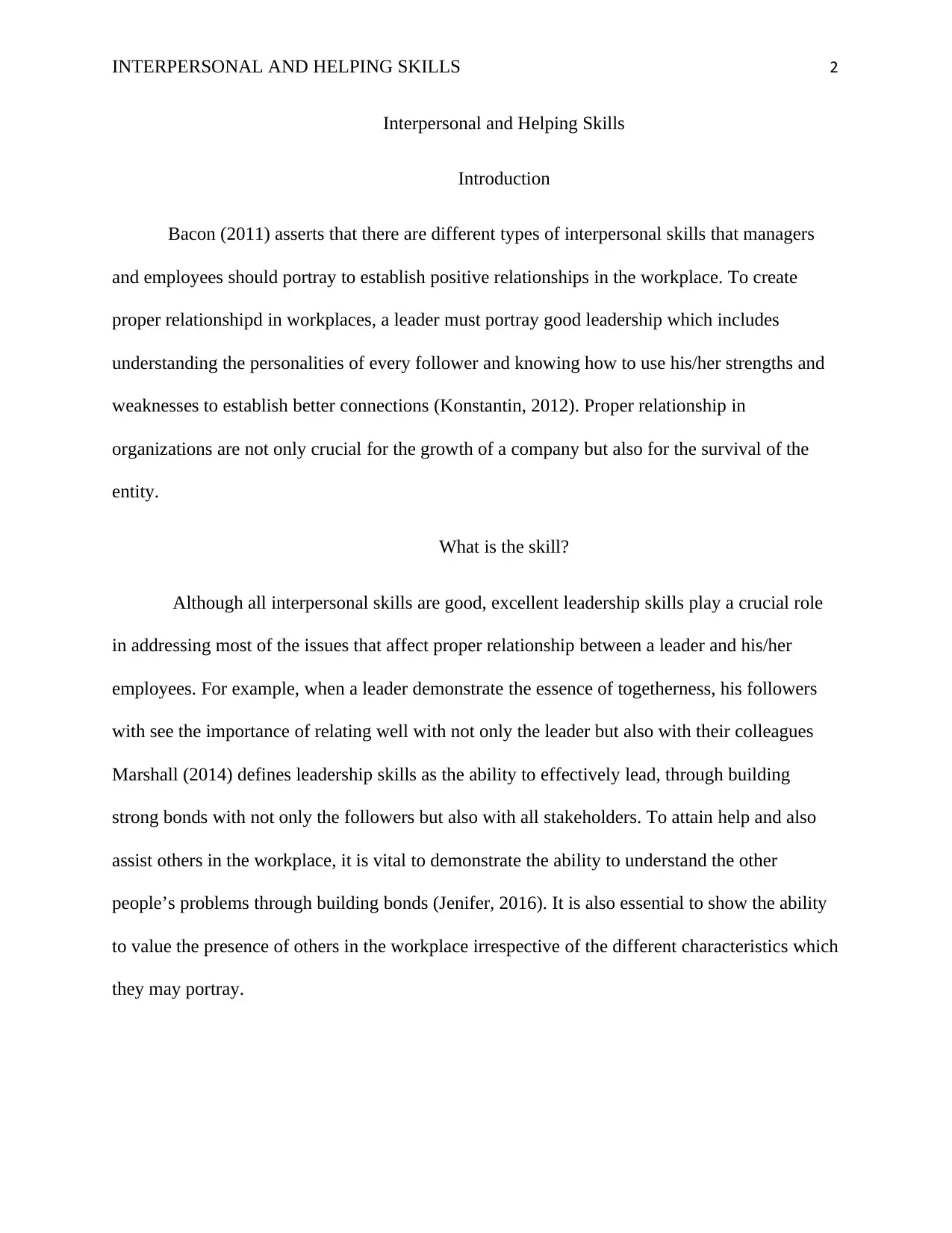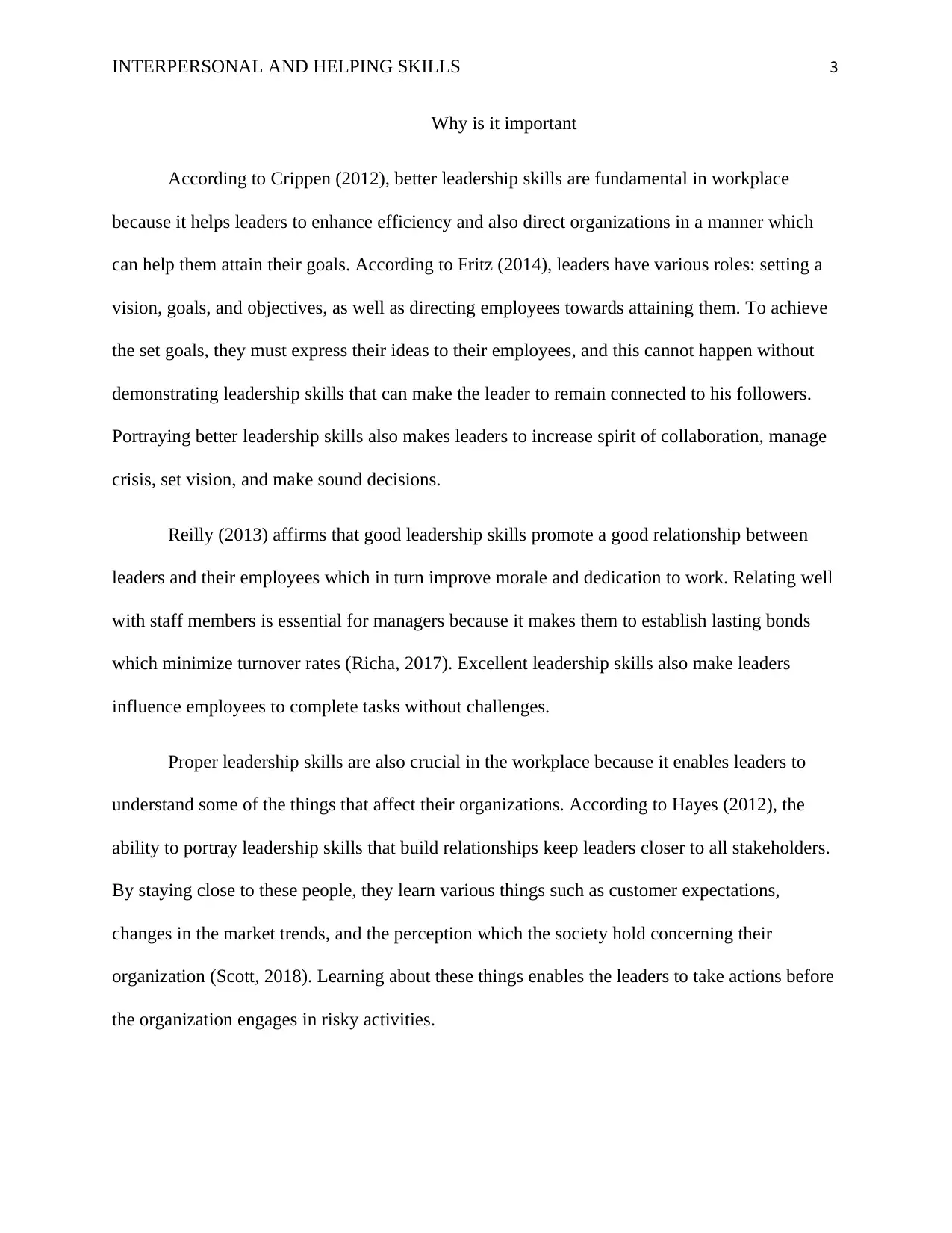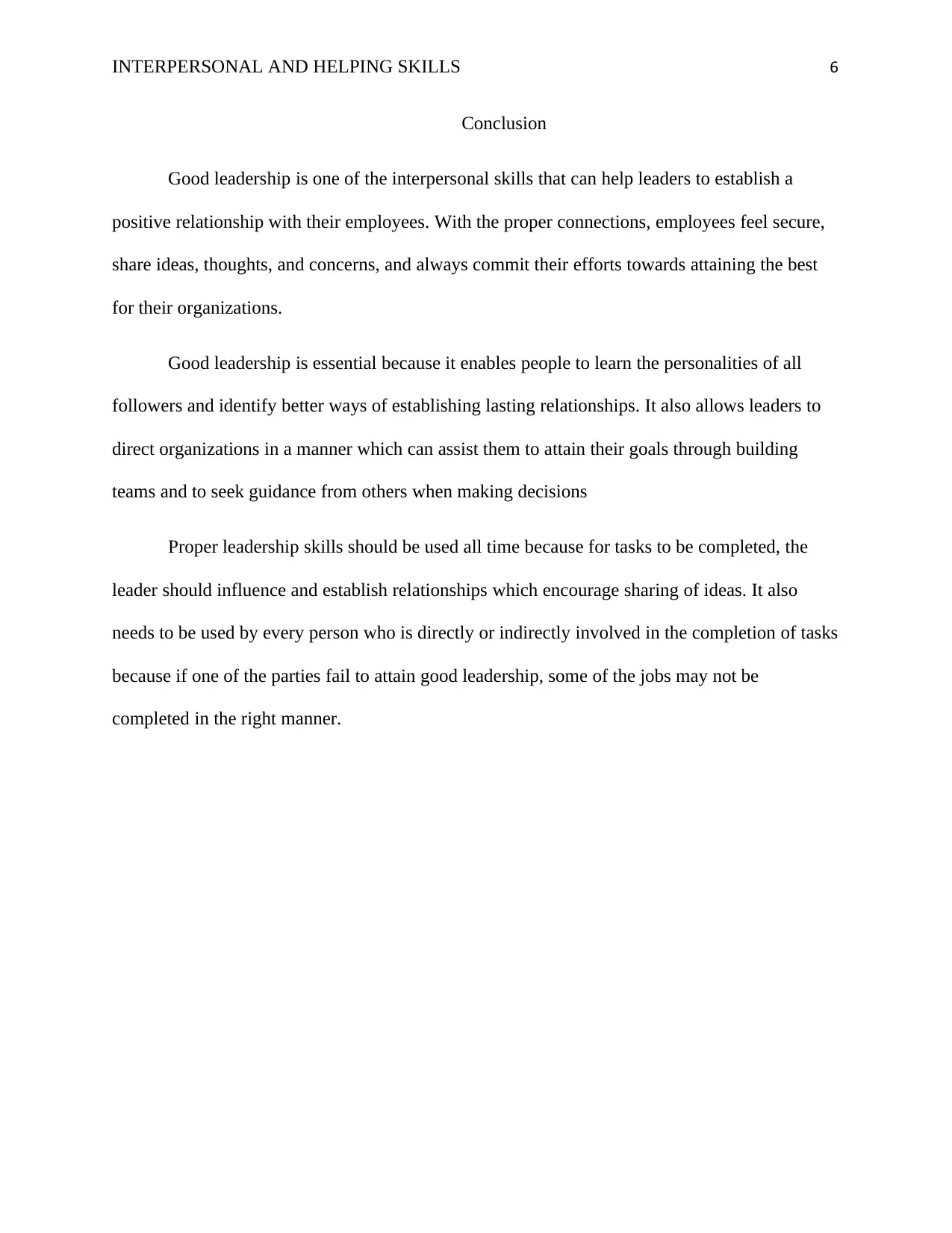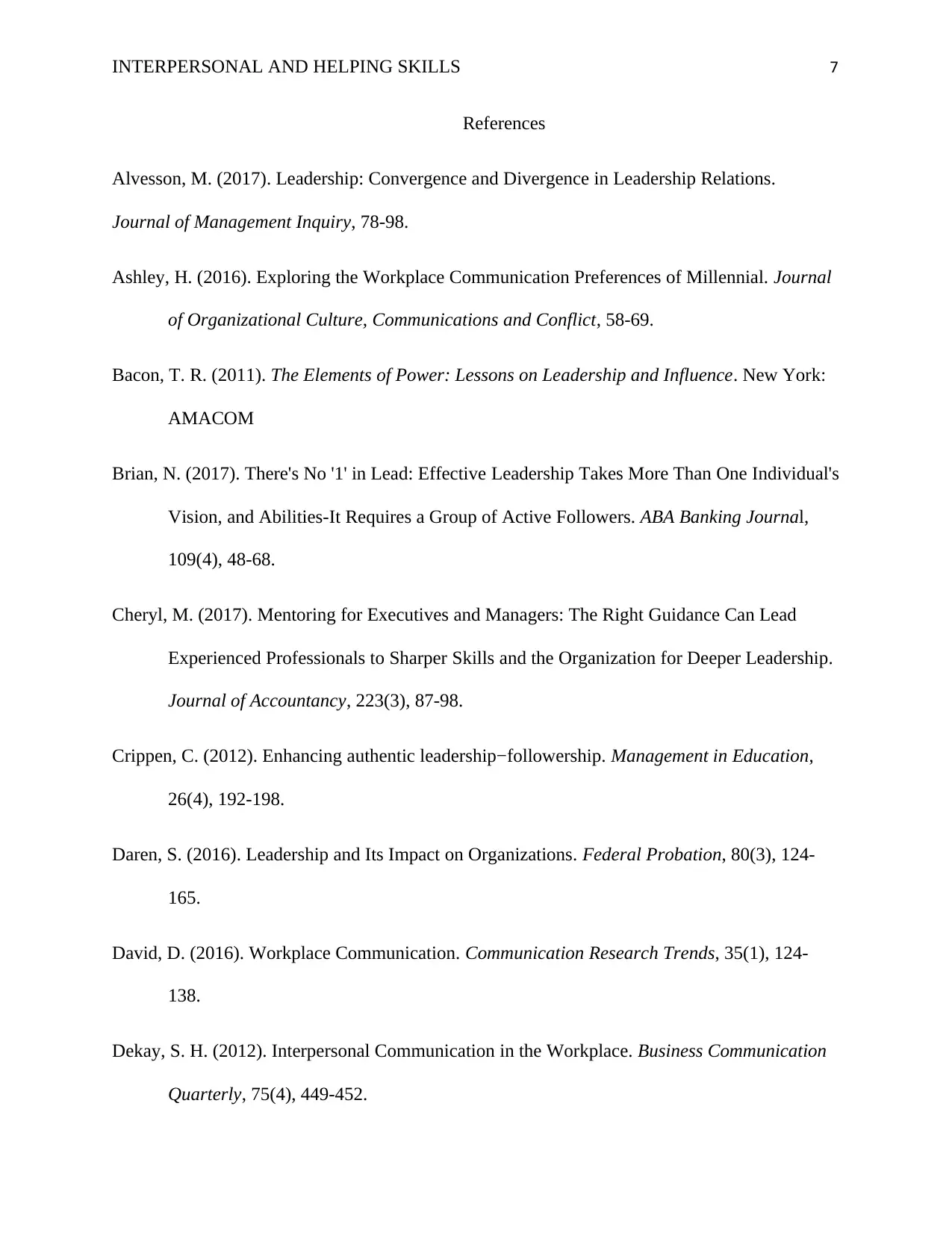Interpersonal and Helping Skills: Importance in the Workplace Report
VerifiedAdded on 2021/05/30
|9
|1981
|258
Report
AI Summary
This report delves into the critical role of interpersonal and helping skills in fostering positive relationships and effective leadership within the workplace. The report emphasizes the importance of these skills for managers and employees, highlighting how they contribute to enhanced communication, teamwork, and overall organizational success. It discusses how leaders can utilize interpersonal skills to understand and connect with their employees, build strong bonds, and create a collaborative environment. The report also examines when and where these skills are most crucial, emphasizing their application across all departments and in various scenarios. Good leadership is essential because it enables people to learn the personalities of all followers and identify better ways of establishing lasting relationships.

Running Head: INTERPERSONAL AND HELPING SKILLS 1
Interpersonal and Helping Skills
Names
Institution
Interpersonal and Helping Skills
Names
Institution
Paraphrase This Document
Need a fresh take? Get an instant paraphrase of this document with our AI Paraphraser

INTERPERSONAL AND HELPING SKILLS 2
Interpersonal and Helping Skills
Introduction
Bacon (2011) asserts that there are different types of interpersonal skills that managers
and employees should portray to establish positive relationships in the workplace. To create
proper relationshipd in workplaces, a leader must portray good leadership which includes
understanding the personalities of every follower and knowing how to use his/her strengths and
weaknesses to establish better connections (Konstantin, 2012). Proper relationship in
organizations are not only crucial for the growth of a company but also for the survival of the
entity.
What is the skill?
Although all interpersonal skills are good, excellent leadership skills play a crucial role
in addressing most of the issues that affect proper relationship between a leader and his/her
employees. For example, when a leader demonstrate the essence of togetherness, his followers
with see the importance of relating well with not only the leader but also with their colleagues
Marshall (2014) defines leadership skills as the ability to effectively lead, through building
strong bonds with not only the followers but also with all stakeholders. To attain help and also
assist others in the workplace, it is vital to demonstrate the ability to understand the other
people’s problems through building bonds (Jenifer, 2016). It is also essential to show the ability
to value the presence of others in the workplace irrespective of the different characteristics which
they may portray.
Interpersonal and Helping Skills
Introduction
Bacon (2011) asserts that there are different types of interpersonal skills that managers
and employees should portray to establish positive relationships in the workplace. To create
proper relationshipd in workplaces, a leader must portray good leadership which includes
understanding the personalities of every follower and knowing how to use his/her strengths and
weaknesses to establish better connections (Konstantin, 2012). Proper relationship in
organizations are not only crucial for the growth of a company but also for the survival of the
entity.
What is the skill?
Although all interpersonal skills are good, excellent leadership skills play a crucial role
in addressing most of the issues that affect proper relationship between a leader and his/her
employees. For example, when a leader demonstrate the essence of togetherness, his followers
with see the importance of relating well with not only the leader but also with their colleagues
Marshall (2014) defines leadership skills as the ability to effectively lead, through building
strong bonds with not only the followers but also with all stakeholders. To attain help and also
assist others in the workplace, it is vital to demonstrate the ability to understand the other
people’s problems through building bonds (Jenifer, 2016). It is also essential to show the ability
to value the presence of others in the workplace irrespective of the different characteristics which
they may portray.

INTERPERSONAL AND HELPING SKILLS 3
Why is it important
According to Crippen (2012), better leadership skills are fundamental in workplace
because it helps leaders to enhance efficiency and also direct organizations in a manner which
can help them attain their goals. According to Fritz (2014), leaders have various roles: setting a
vision, goals, and objectives, as well as directing employees towards attaining them. To achieve
the set goals, they must express their ideas to their employees, and this cannot happen without
demonstrating leadership skills that can make the leader to remain connected to his followers.
Portraying better leadership skills also makes leaders to increase spirit of collaboration, manage
crisis, set vision, and make sound decisions.
Reilly (2013) affirms that good leadership skills promote a good relationship between
leaders and their employees which in turn improve morale and dedication to work. Relating well
with staff members is essential for managers because it makes them to establish lasting bonds
which minimize turnover rates (Richa, 2017). Excellent leadership skills also make leaders
influence employees to complete tasks without challenges.
Proper leadership skills are also crucial in the workplace because it enables leaders to
understand some of the things that affect their organizations. According to Hayes (2012), the
ability to portray leadership skills that build relationships keep leaders closer to all stakeholders.
By staying close to these people, they learn various things such as customer expectations,
changes in the market trends, and the perception which the society hold concerning their
organization (Scott, 2018). Learning about these things enables the leaders to take actions before
the organization engages in risky activities.
Why is it important
According to Crippen (2012), better leadership skills are fundamental in workplace
because it helps leaders to enhance efficiency and also direct organizations in a manner which
can help them attain their goals. According to Fritz (2014), leaders have various roles: setting a
vision, goals, and objectives, as well as directing employees towards attaining them. To achieve
the set goals, they must express their ideas to their employees, and this cannot happen without
demonstrating leadership skills that can make the leader to remain connected to his followers.
Portraying better leadership skills also makes leaders to increase spirit of collaboration, manage
crisis, set vision, and make sound decisions.
Reilly (2013) affirms that good leadership skills promote a good relationship between
leaders and their employees which in turn improve morale and dedication to work. Relating well
with staff members is essential for managers because it makes them to establish lasting bonds
which minimize turnover rates (Richa, 2017). Excellent leadership skills also make leaders
influence employees to complete tasks without challenges.
Proper leadership skills are also crucial in the workplace because it enables leaders to
understand some of the things that affect their organizations. According to Hayes (2012), the
ability to portray leadership skills that build relationships keep leaders closer to all stakeholders.
By staying close to these people, they learn various things such as customer expectations,
changes in the market trends, and the perception which the society hold concerning their
organization (Scott, 2018). Learning about these things enables the leaders to take actions before
the organization engages in risky activities.
⊘ This is a preview!⊘
Do you want full access?
Subscribe today to unlock all pages.

Trusted by 1+ million students worldwide

INTERPERSONAL AND HELPING SKILLS 4
Who needs to use it?
Proper leadership skills should be used by not only the leaders but also the employees
(Daren, 2016). This is because for relationships to be built in workplaces, the employees should
also demonstrate the ability to lead not only in the workplace but also in their families. (Hanson,
2012). Being demonstrated by both the leaders and employees enhances the relationships
because each one understands why building connections are fundamental to the organization.
According to David (2016), proper leadership skills attains its value when all teams
connect. Because the primary purpose of this type of interpersonal skill is to direct and connect
with all stakeholders, it should exist in employees and their leaders so that the staff members can
understand the importance of being led, and the leader to know why he should direct the
employees through enhancing relationships (Brian, 2017).
When is to be used?
According to Fritz (2014), excellent leadership skills should be used at all times when
performing day to day activities in an organization. The reason why using these skills all times is
that it enables managers to connect with their employees, share ideas and identify things that
affect performance. It also allows business leaders to consult when making decisions (Paul,
2012). Leadership skills also needs to be used every time because these skills are considered as
integral part of management, and are essential in making firms to attain their goals.
The other reason why leadership skills should be used all times is that an organization
cannot thrive without a proper relationship between leaders and their staff members, and these
relationships cannot be established without portraying the qualities of good leaders such as
adaptability, being charismatic, encouraging teamwork and so forth. According to Ashley
Who needs to use it?
Proper leadership skills should be used by not only the leaders but also the employees
(Daren, 2016). This is because for relationships to be built in workplaces, the employees should
also demonstrate the ability to lead not only in the workplace but also in their families. (Hanson,
2012). Being demonstrated by both the leaders and employees enhances the relationships
because each one understands why building connections are fundamental to the organization.
According to David (2016), proper leadership skills attains its value when all teams
connect. Because the primary purpose of this type of interpersonal skill is to direct and connect
with all stakeholders, it should exist in employees and their leaders so that the staff members can
understand the importance of being led, and the leader to know why he should direct the
employees through enhancing relationships (Brian, 2017).
When is to be used?
According to Fritz (2014), excellent leadership skills should be used at all times when
performing day to day activities in an organization. The reason why using these skills all times is
that it enables managers to connect with their employees, share ideas and identify things that
affect performance. It also allows business leaders to consult when making decisions (Paul,
2012). Leadership skills also needs to be used every time because these skills are considered as
integral part of management, and are essential in making firms to attain their goals.
The other reason why leadership skills should be used all times is that an organization
cannot thrive without a proper relationship between leaders and their staff members, and these
relationships cannot be established without portraying the qualities of good leaders such as
adaptability, being charismatic, encouraging teamwork and so forth. According to Ashley
Paraphrase This Document
Need a fresh take? Get an instant paraphrase of this document with our AI Paraphraser

INTERPERSONAL AND HELPING SKILLS 5
(2016), when a leader portray these skills, his/her followers tend to appreciate him because they
see him as a person who is dedicated to attaining the best not only for the organization but also
for the employees.
Portraying good leadership skills all times is also fundamental in making employees to
feel comfortable while undertaking their tasks. Dekay (2012) asserts that when a person portrays
good leadership skills, his/her followers develop positive perception towards him/her, and
always like socialization with the leader while undertaking different tasks. This socialization is
fundamental because it makes the followers to feel motivated and also empowered to conduct
their responsibilities in the right manner (Alvesson, 2017).
Where this skill is most used/needed
Proper leadership skills are required in all departments in an organization and also during
a social work scenario. This is because when performing duties, people need to be directed and
inspired to fully commit their efforts towards attaining better outcome (Geldard et al, 2016). In a
social work scenario that includes environmental conservation, for instance, leaders will need to
have proper leadership skills to enhance teamwork and also to direct the teams on how to
accomplish this activity in a manner which can aid in attaining the set goals.
Excellent leadership enhance the ability of people to share ideas, thoughts, and concerns
with each other. When used in all areas, it becomes easy for employees to accomplish what
seems impossible (Cheryl, 2017). This occurs because when a leader establishes strong
relationship bonds among themselves, they motivate each other, and also share ideas concerning
how to perform tasks which seem to be challenging.
(2016), when a leader portray these skills, his/her followers tend to appreciate him because they
see him as a person who is dedicated to attaining the best not only for the organization but also
for the employees.
Portraying good leadership skills all times is also fundamental in making employees to
feel comfortable while undertaking their tasks. Dekay (2012) asserts that when a person portrays
good leadership skills, his/her followers develop positive perception towards him/her, and
always like socialization with the leader while undertaking different tasks. This socialization is
fundamental because it makes the followers to feel motivated and also empowered to conduct
their responsibilities in the right manner (Alvesson, 2017).
Where this skill is most used/needed
Proper leadership skills are required in all departments in an organization and also during
a social work scenario. This is because when performing duties, people need to be directed and
inspired to fully commit their efforts towards attaining better outcome (Geldard et al, 2016). In a
social work scenario that includes environmental conservation, for instance, leaders will need to
have proper leadership skills to enhance teamwork and also to direct the teams on how to
accomplish this activity in a manner which can aid in attaining the set goals.
Excellent leadership enhance the ability of people to share ideas, thoughts, and concerns
with each other. When used in all areas, it becomes easy for employees to accomplish what
seems impossible (Cheryl, 2017). This occurs because when a leader establishes strong
relationship bonds among themselves, they motivate each other, and also share ideas concerning
how to perform tasks which seem to be challenging.

INTERPERSONAL AND HELPING SKILLS 6
Conclusion
Good leadership is one of the interpersonal skills that can help leaders to establish a
positive relationship with their employees. With the proper connections, employees feel secure,
share ideas, thoughts, and concerns, and always commit their efforts towards attaining the best
for their organizations.
Good leadership is essential because it enables people to learn the personalities of all
followers and identify better ways of establishing lasting relationships. It also allows leaders to
direct organizations in a manner which can assist them to attain their goals through building
teams and to seek guidance from others when making decisions
Proper leadership skills should be used all time because for tasks to be completed, the
leader should influence and establish relationships which encourage sharing of ideas. It also
needs to be used by every person who is directly or indirectly involved in the completion of tasks
because if one of the parties fail to attain good leadership, some of the jobs may not be
completed in the right manner.
Conclusion
Good leadership is one of the interpersonal skills that can help leaders to establish a
positive relationship with their employees. With the proper connections, employees feel secure,
share ideas, thoughts, and concerns, and always commit their efforts towards attaining the best
for their organizations.
Good leadership is essential because it enables people to learn the personalities of all
followers and identify better ways of establishing lasting relationships. It also allows leaders to
direct organizations in a manner which can assist them to attain their goals through building
teams and to seek guidance from others when making decisions
Proper leadership skills should be used all time because for tasks to be completed, the
leader should influence and establish relationships which encourage sharing of ideas. It also
needs to be used by every person who is directly or indirectly involved in the completion of tasks
because if one of the parties fail to attain good leadership, some of the jobs may not be
completed in the right manner.
⊘ This is a preview!⊘
Do you want full access?
Subscribe today to unlock all pages.

Trusted by 1+ million students worldwide

INTERPERSONAL AND HELPING SKILLS 7
References
Alvesson, M. (2017). Leadership: Convergence and Divergence in Leadership Relations.
Journal of Management Inquiry, 78-98.
Ashley, H. (2016). Exploring the Workplace Communication Preferences of Millennial. Journal
of Organizational Culture, Communications and Conflict, 58-69.
Bacon, T. R. (2011). The Elements of Power: Lessons on Leadership and Influence. New York:
AMACOM
Brian, N. (2017). There's No '1' in Lead: Effective Leadership Takes More Than One Individual's
Vision, and Abilities-It Requires a Group of Active Followers. ABA Banking Journal,
109(4), 48-68.
Cheryl, M. (2017). Mentoring for Executives and Managers: The Right Guidance Can Lead
Experienced Professionals to Sharper Skills and the Organization for Deeper Leadership.
Journal of Accountancy, 223(3), 87-98.
Crippen, C. (2012). Enhancing authentic leadership−followership. Management in Education,
26(4), 192-198.
Daren, S. (2016). Leadership and Its Impact on Organizations. Federal Probation, 80(3), 124-
165.
David, D. (2016). Workplace Communication. Communication Research Trends, 35(1), 124-
138.
Dekay, S. H. (2012). Interpersonal Communication in the Workplace. Business Communication
Quarterly, 75(4), 449-452.
References
Alvesson, M. (2017). Leadership: Convergence and Divergence in Leadership Relations.
Journal of Management Inquiry, 78-98.
Ashley, H. (2016). Exploring the Workplace Communication Preferences of Millennial. Journal
of Organizational Culture, Communications and Conflict, 58-69.
Bacon, T. R. (2011). The Elements of Power: Lessons on Leadership and Influence. New York:
AMACOM
Brian, N. (2017). There's No '1' in Lead: Effective Leadership Takes More Than One Individual's
Vision, and Abilities-It Requires a Group of Active Followers. ABA Banking Journal,
109(4), 48-68.
Cheryl, M. (2017). Mentoring for Executives and Managers: The Right Guidance Can Lead
Experienced Professionals to Sharper Skills and the Organization for Deeper Leadership.
Journal of Accountancy, 223(3), 87-98.
Crippen, C. (2012). Enhancing authentic leadership−followership. Management in Education,
26(4), 192-198.
Daren, S. (2016). Leadership and Its Impact on Organizations. Federal Probation, 80(3), 124-
165.
David, D. (2016). Workplace Communication. Communication Research Trends, 35(1), 124-
138.
Dekay, S. H. (2012). Interpersonal Communication in the Workplace. Business Communication
Quarterly, 75(4), 449-452.
Paraphrase This Document
Need a fresh take? Get an instant paraphrase of this document with our AI Paraphraser

INTERPERSONAL AND HELPING SKILLS 8
Fritz, J. H. (2014). Researching workplace relationships. Journal of Social and Personal
Relationships, 31(4), 460-466.
Geldard, D., Geldard, K. & Foo, Y. R. (2016). Basic personal counselling: A training manual
for counsellors (8th ed.). NSW: Cengage Learning Australia.
Hanson, B. (2012). The Leadership Development Interface. Advances in Developing Human
Resources, 15(1), 106-120.
Hayes, J. (2012). Interpersonal Skills at Work. New York: Routledge
Jenifer, B. (2016). Interpersonal Skills in the Practice of Food Safety Inspections: A Study of
Compliance Assistance, Journal of Environmental Health, 79(5), 56-78.
Konstantin, P. (2012). Required Skills and Leadership Characteristics of a Modern Manager in
Tourism and Hospitality. UTMS Journal of Economics, 3(1), 25-68.
Marshall, K. M. (2014). Critical Communication Skills: Developing Course Competencies to
Meet Workforce Needs. The Journal of Research in Business Education, 56(2), 87-102.
Paul, B. (2012). Good Coaching Leads to Good Leadership: There Is No Magic Elixir for
Leadership. Those Skills Can Be Taught and Learned and Practiced until They Become
Second Nature. Phi Delta Kappan, 94(4), 254-238.
Reilly, E. T. (2013). AMA Business Boot Camp: Management and Leadership Fundamentals
That Will See You Successfully Through Your Career. New York: American Management
Association
Richa, A. N. (2017). Cases in Leadership. South Asian Journal of Management, 24(3), 65-78.
Fritz, J. H. (2014). Researching workplace relationships. Journal of Social and Personal
Relationships, 31(4), 460-466.
Geldard, D., Geldard, K. & Foo, Y. R. (2016). Basic personal counselling: A training manual
for counsellors (8th ed.). NSW: Cengage Learning Australia.
Hanson, B. (2012). The Leadership Development Interface. Advances in Developing Human
Resources, 15(1), 106-120.
Hayes, J. (2012). Interpersonal Skills at Work. New York: Routledge
Jenifer, B. (2016). Interpersonal Skills in the Practice of Food Safety Inspections: A Study of
Compliance Assistance, Journal of Environmental Health, 79(5), 56-78.
Konstantin, P. (2012). Required Skills and Leadership Characteristics of a Modern Manager in
Tourism and Hospitality. UTMS Journal of Economics, 3(1), 25-68.
Marshall, K. M. (2014). Critical Communication Skills: Developing Course Competencies to
Meet Workforce Needs. The Journal of Research in Business Education, 56(2), 87-102.
Paul, B. (2012). Good Coaching Leads to Good Leadership: There Is No Magic Elixir for
Leadership. Those Skills Can Be Taught and Learned and Practiced until They Become
Second Nature. Phi Delta Kappan, 94(4), 254-238.
Reilly, E. T. (2013). AMA Business Boot Camp: Management and Leadership Fundamentals
That Will See You Successfully Through Your Career. New York: American Management
Association
Richa, A. N. (2017). Cases in Leadership. South Asian Journal of Management, 24(3), 65-78.

INTERPERSONAL AND HELPING SKILLS 9
Scott, L. (2018). Transformational Executive Leadership: How and Why? ABA Banking Journal,
110(1), 457-466.
Scott, L. (2018). Transformational Executive Leadership: How and Why? ABA Banking Journal,
110(1), 457-466.
⊘ This is a preview!⊘
Do you want full access?
Subscribe today to unlock all pages.

Trusted by 1+ million students worldwide
1 out of 9
Related Documents
Your All-in-One AI-Powered Toolkit for Academic Success.
+13062052269
info@desklib.com
Available 24*7 on WhatsApp / Email
![[object Object]](/_next/static/media/star-bottom.7253800d.svg)
Unlock your academic potential
Copyright © 2020–2025 A2Z Services. All Rights Reserved. Developed and managed by ZUCOL.




